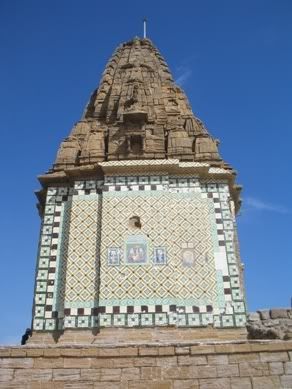 In the past we have shared with you some photos of Manora Island under the title views of Manora. Today we will go on an exclusive tour of Shri Varun Dev mandir located at the Manora beach.
In the past we have shared with you some photos of Manora Island under the title views of Manora. Today we will go on an exclusive tour of Shri Varun Dev mandir located at the Manora beach.
(Photo to the right is the view of the mandir facing Arabian Sea.)
The mandir is unfortunately in a bad condition of disrepair and salty-rusty sea breeze is eating away into the structure fast. When I visited the mandir on Jan 7, 2007, it appeared deserted. There were unfortunate signs of human vandalism also where it looked like people took away with them any item salvagable. The structure still appeared grand and from left over tile work and decorations it showed its glorious past.
Date of Construction:
Mr Hari Motwani, who is General Secretary of Pakistan Hindu Council – 2009 provides a brief history and year of construction of this mandir in his comments below in following words:
(The Mandir was) built in 1917 (record available) and renovated in 1937-40 (tiles fixed). Lokram Dodeja, journalist from Shikarpur, have given reference in his book -1938 that he used to visit Monora Mandir every Sunday, (where) he got Saag & Dhodho as parsad, (and) the well inside the temple had sweet water.
(2) Here is a memorial tablet in Sindhi on one of the mandir gates.

Our avid reader Khair Soomro saheb helped me in translating this tablet. It reads:
“dedication from sons in the sacred memory of Seth Harchand Mal Dayal Das of Bhriya”
or in other words: “An offering from sons in the loving memory of their father Seth Harchand Mal Dayal Das of Bhriya”. (Bhriya is a town near Khairpur Sindh.)
(3) View of the mandir from West side
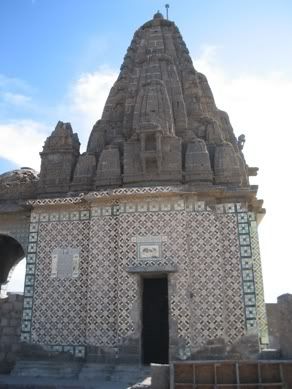
Note the details of the elaborate stone work done on the roof of this mandir. The tile work near the base is in obvious state of disrepair. I took this photo of January 7, 2007.
(4) This tablet tells us about the sponsors of colorful tile work in two languages.
Top script is Sindhi.
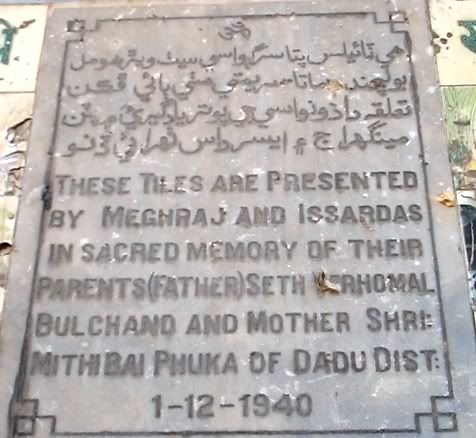
(5) The tile work of mandir floor

(6) Looking at the mandir from east
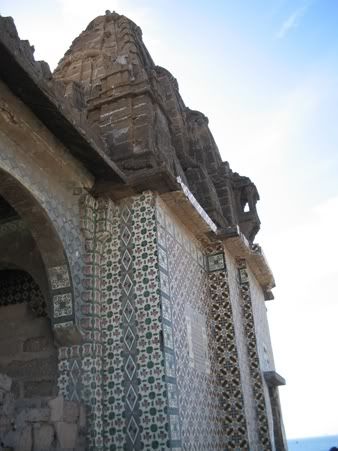
(7) The outer gate of the mandir
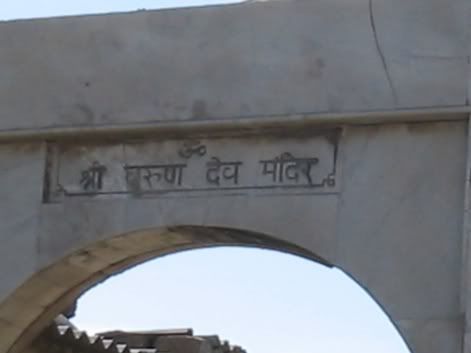
I asked my good friend Sridhar to translate the devnagri script for us and here was his reply:
“The top line has the character ‘Om’. It is just an auspicious syllable that is there in most prayers and is also present in most places of worship. The second line has the name of the temple (and presumably the chief deity worshipped there). It says ‘Shri Varun Dev Mandir’. The name also looks like ‘Shri Arun Dev Mandir’ (the ancient way of writing ‘A’ in Arun could well be imagined in that character, which is not that clear. But I think, on balance that it is Varun Dev and not Arun. According to Hindu mythology Varuna is the God of the oceans. There is no worship of Varuna that I have come across personally in India, though I would not be completely surprised at the existence of this temple in Karachi because of the enormous diversity in the Hinduism practiced in different parts of the subcontinent. Also, people who have livelihoods related to the ocean, for instance, fishermen, might worship Varuna. If this temple is on the beach in Karachi this could well be an explanation – it might have been built by fishermen who worshipped Varuna.”
I have a sincere hope that Government of Pakistan takes care of these places of worship. If nothing else then atleast the structure should be saved from the people who take away tiles and anything salvagable for petty profits. Many people visit the mandir as it is the largest and most prominent attraction at Manora beach. A little bit of official or non-official help will go a long way in preserving our heritage.
(8) View from the outer most gate of the mandir compound
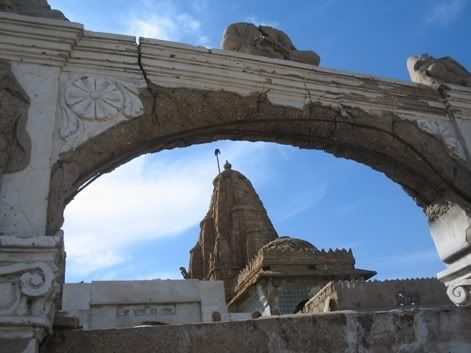
I’ve recently read that in June 2007, The station Commander PNS Himalaya Manora cantt has handed over the control of this temple to Pakistan Hindu Council Karachi, which is now working on the restoration work. PHC’s website introduces the mandir in following words:
Varun God (Radha Krishna – Sita Ram) Temple At Manora Cantt
The temple is situated on seashore of Manora cantt. This temple is about 160 years old (1850s?reference needed about this time line) and designed perfectly as per Hindu Architecture. The temple is carved from a blackish marble. Apart of Varun Devta temple there is small temple of Shiv Shanker & statues of Hanuman & Sri Ganesh Mahraj are still in good condition. Sindhi Hindu Businessmen built this temple & renovated from time to time. After partition the temple was abandoned and illegally occupied by land grabbers, recently Pakistan Hindu Council Karachi took a bold step to renovate the same and how have brought back the sanctity of temple & have been cleaned of all the impurities & garbage inside the temple. The station Commander PNS Himalaya Manora cantt has very kindly handed over the control of this temple to Pakistan Hindu Council Karachi, from June, 2007.The Council plans to spend about Ten million rupees for uplift and to bring this ancient temple to its original condition. Satsung will be held on every Saturday and Parsad and Bhandara would also be managed every week free of cost. Lot of devotes visit this picnic place and enjoy the waves of sea direcltly hitting the temple. There is beautiful scene early in the morning at sun rise. The atmosphere is marvelous and one feels great pleasure & peace of mind along with glimpses of the temple and Darshan of Lord Shri Ram and Lord Shri Krishna.
(9) Following is the tile work on mandir’s exterior wall
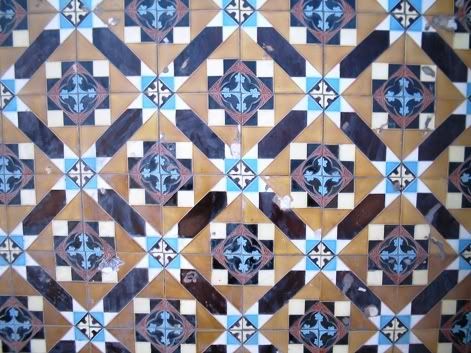
Reference: Pakistan Hindu Council


















































Assalam-o-alaikum.
First of all, many thanks for sharing beautiful pictures of Shri Varun Dev’s Mandir at Manora Island. I also visited that Mandir in year 2004 and took lots of photographs but I could not get such beautiful pictures.
It seems that Karachi’s city government has recently did something to preserve that temple because it was of course in miserable condition in year 2004.
By the way, I am not agreed with Mr. Pervaiz Munir Alvi. It isn’t true that an Islamic government will prefer to demolish such non-muslim buildings. He should not forget that the most beautiful temples were built in the Sub-Continent during the period of Muslim Rulers.
It is true that Sultan Mehmood Ghaznavi destroyed lots of Hindu temples in Somnaat but there was a reason behind that. But rest of other Mughal, Ghauri, Aibak and Khilji Rulers constructed the best temples in Sub-continent.
Regards,
Farhan
hello everyone
thanx for your valuable info, i wanted to know that what are the other activities(rituals or festivals) associated with this temple because i think it cannot be preserved in isolation, one should cater linked activities too.
great info, i came across this website by chance. it is great to know that there is an atmosphere of respect amongst you all regardless of backgrounds and religions. you are upholding the traditions and the future of the sub continent.
mr alvi, maybe you can learn something for the others. clearly not everyone is as negative and obstructive as you are!!
Owais has done a neat job of taking meaningful pictures. Cheers, mate! As a Hindu and as a vehement advocate of preserving any historic structure of grace and beauty, its sad to see á temple in such a state of wanton abandon, and state apathy. What is heartening though is to find an increasing number of modern Pakistanis (mostly the Y-generation) who see a reason to preserve what is undeniably the joint heritage of the people who once lived there and the people who do now. Having said that this view of heritage cannot be forced down the throat of someone who chooses to see otherwise (like Pervaiz Munie Alvi). To each his own…
However, its my personal view that the young Pakistanis I see today (i live in Dubai and have two good Pakistani friends) don’t seem encumbered with the baggage of hatred that old-timers carry in both India and Pakistan. These pakistanis to me represent a new people – secure in their muslim identity, yet proud of all aspects of their rich cultural heritage, including elements of their Hindu past. “Idol smashing” might’ve looked like an obvious thing to do to an Arab conqueror who wanted to “destroy the religion of these infidels”. But a thousand years later, when the Pakistan of today is an entirely Muslim country founded and ruled by Muslims, can Pervez or others who think like him offer any reasonable justification for harboring such violent “traditions”? You may nurse any amount of hatred for Indians (if you must), but what is the point of hating elements of your own Hindu heritage? WOuld you not like to preserve it just as you preserve the other elements (Mughal, Turkish, Arab) of your proud heritage? I cannot help but admire and respect guys like Owais Mughal here.
[…] we have regularly discussed preservation of our art, architecture and heritage. For example here, here, and here. This post falls in the same category. Today’s news is that Italy is going to […]